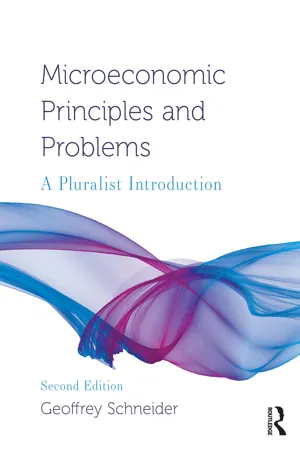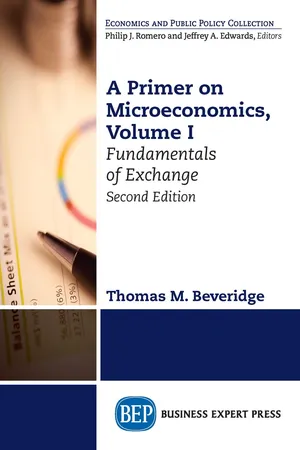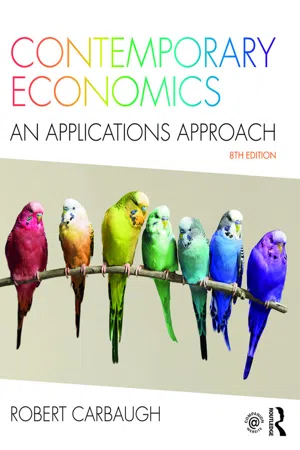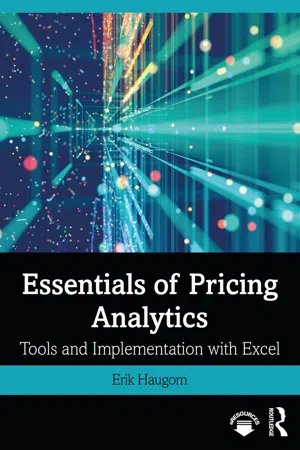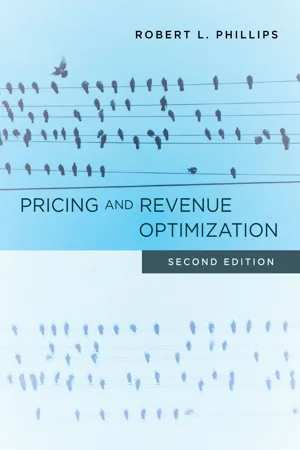Economics
Price Elasticity of Demand
Price Elasticity of Demand measures the responsiveness of quantity demanded to a change in price. It is calculated as the percentage change in quantity demanded divided by the percentage change in price. If the value is greater than 1, demand is considered elastic, meaning quantity demanded is highly responsive to price changes. If the value is less than 1, demand is inelastic, indicating quantity demanded is less responsive to price changes.
Written by Perlego with AI-assistance
Related key terms
11 Key excerpts on "Price Elasticity of Demand"
- eBook - ePub
Microeconomic Principles and Problems
A Pluralist Introduction
- Geoffrey Schneider(Author)
- 2024(Publication Date)
- Routledge(Publisher)
Now that we have described how price floors, price ceilings, excise taxes, and per-unit subsidies affect the supply and demand model, we need to explore the topic of elasticity in more detail. Elasticity is an extremely useful concept for both consumers and producers to understand. It is particularly important for business owners trying to understand their consumer base and how they will respond to different pricing strategies.10.5 THE Price Elasticity of Demand
Price Elasticity of Demand refers to the responsiveness of quantity demanded to changes in price. In mathematical terms, the Price Elasticity of Demand, eD , is equal to the percentage change in the quantity demanded divided by the percentage change in price. The Price Elasticity of Demand is less than or equal to zero, eD ≤ 0, because of the negative slope of the demand curve. In mathematical terms, the Price Elasticity of Demand (eD ) can be written as follows:2e D==% ▵Q D% ▵ P=▵ QQ 1▵ PP 1(Q 2−Q 1)Q 1(P 2−P 1)P 110.5.1 Price inelastic demand
In general, a demand curve is said to be price inelastic if a change in price causes very little change in the quantity demanded. Inelastic demand curves tend to be steep. Notice that in the equation for the Price Elasticity of Demand, if the percentage change in quantity is very small compared to the percentage change in price, we will get a fraction for eD because the numerator will be smaller than the denominator in absolute value. We use the absolute value to compare the magnitude of the change in price and the change in quantity demanded because one of the numbers will be negative given the negative slope of the demand curve. So, when the demand curve is price inelastic, the absolute value of the Price Elasticity of Demand is between 0 and 1: 0 < |eD - eBook - ePub
A Primer on Microeconomics, Second Edition, Volume I
Fundamentals of Exchange
- Thomas M. Beveridge(Author)
- 2018(Publication Date)
- Business Expert Press(Publisher)
Have you ever shopped around for the best price on airline tickets or hotel accommodation? Most of us have, and nowadays, the Internet helps us to do this with sites such as Travelocity and Expedia. But have you ever shopped around for the best price on electricity service for your home? Probably not, because for most of us, the electricity company we have is a “take it or leave it” situation and we have little flexibility, short of installing our own solar panels. In the case of airline tickets, we can be choosy and responsive to price differences, but in the case of electricity, we can’t. This brings us to a consideration of “elasticity.”Elasticity: A Measure of Responsiveness The Big Idea of ElasticityStudents of economics frequently complain that although there is a lot of theory, there are few practical numbers based on real-world experience. We know, for example, that an increase in price causes a decrease in quantity demanded, but we don’t know how much of a decrease there is. Is it a big decrease or a small decrease? Elasticity (a fancy word for “responsiveness” or “sensitivity”) answers this sort of a question. Price Elasticity of Demand measures how responsive or sensitive demanders are to a change in price—how much do they react to a price change? Income elasticity of demand measures how much demanders respond when income level changes—if there is a recession and income levels fall, how much will the demand for cars decrease? Cros s-Price Elasticity of Demand measures how much the demand for one good changes when the price of a related good changes—if the price of Coca-Cola increases, how much does the demand for Pepsi increase? Price elasticity of supply measures how much the quantity supplied of a good will increase as its price rises—is it a large response (relatively “elastic”) or a small response (relatively “inelastic”)?In any elasticity calculation, we measure the extent of the change in one variable relative to the change in another variable. We could, for example, develop an “advertising elasticity of demand” to show how much the demand for our product changes as our advertising budget increases.Price Elasticity of DemandConsidering Price Elasticity of Demand, we can establish an “intuitive” formula that will answer many of our questions quite simply. Price Elasticity of Demand (Ed ) measures how much quantity demanded (Qd - eBook - ePub
- Andrew Barkley, Paul W. Barkley(Authors)
- 2016(Publication Date)
- Routledge(Publisher)
Elasticities are unitless, and therefore attractive to social scientists who make comparisons among elasticities across all goods. The definition of price elasticity makes this clear:(9.7) Ed = (ΔQd /ΔP)*(P/Qd ).Since the price (P) and quantity demanded (Qd ) appear in the numerator and the denominator, the units of each cancel, leaving no units for an elasticity calculation. Hence, economists use elasticities rather than slopes to measure the responsiveness of consumer purchases to changes in prices and other economic variables. These unitless elasticities allow an unbiased comparison of the market responsiveness of apples and oranges.To summarize the discussion, elasticities measure how responsive consumers are to changes in price. An elastic demand curve shows that consumers are more responsive to price changes, while an inelastic demand curve reveals that consumers are not so likely to change their buying habits in response to price changes. The elasticities are comparable across all goods. The major determinant of the elasticity of demand is the availability of substitutes. If substitutes are available, then, when the price of a good increases, consumers switch to the lower-priced product.The Price Elasticity of Demand explains many market-related situations. For example, gasoline stations in college towns often charge higher prices for gasoline the day before the beginning of Spring Break. On this day, when several thousand students are preparing to leave town, the demand for gasoline is relatively inelastic: many of the students will fill their cars’ tanks. Station owners know this and increase the price of fuel to take advantage of the fact that the students will pay higher prices in order to fulfill their vacation plans.Veterinarians often charge higher prices for rich people with poodles than for poor people with mixed breed mutts. Why? Because wealthier people are more likely to be willing and able to pay higher prices for vet services than poor people are. The elasticity of demand for medical services is lower (more inelastic) for rich persons than for poor. - eBook - ePub
- Rob Dransfield(Author)
- 2013(Publication Date)
- Routledge(Publisher)
Price Elasticity of Demand – measures the percentage change in quantity demanded caused by a percentage change in price. As such, it measures the extent of movement along the demand curve.Price elasticity of supply – measures how the amount of a good firms wish to supply changes in response to a change in price. Price elasticity of supply captures the extent of movement along the supply curve.In the analysis that follows we will first review elasticity of demand before going on to examine elasticity of supply. Business managers are particularly interested in the extent to which demand is likely to respond to a price change. Measuring the response is referred to as the measurement of price elasticity. In addition, it is helpful to measure the responsiveness of demand to variables other than price – for example:- The responsiveness of demand for a good to changes in the prices of other goods – referred to by economists as cross-price elasticity.
- The responsiveness of demand for a good to changes in income – referred to by economists as income elasticity.
A restaurant owner who is considering increasing prices will first want to know what teffect this will have on the customers. Will there be no effect, a small fall in customers, or a large fall? If the number of customers remains the same or falls by a smaller percentage than the price change, the business will make more revenue. The calculation used to estimate this effect is Price Elasticity of Demand, which measures how quantity demanded for a product responds to a change in its price. Anyone wishing to raise or lower prices should first estimate the price elasticity.Measuring price elasticity Key TermPrice elasticity - Peter Davis, Eliana Garcés(Authors)
- 2009(Publication Date)
- Princeton University Press(Publisher)
15,000 cars would be at most 1,000. On the other hand, the same total income divided more equally could certainly generate sales of more than 1,000. (For recent work, see, for example, Lewbel (2003) and references therein.)1.1.2 Demand Elasticities
Elasticities in general, and demand elasticities in particular, turn out to be very important for lots of areas of competition policy. The reason is that the “Price Elasticity of Demand” provides us with a unit-free measure of the consumer demand response to a price increase.7 The way in which demand changes when prices go up will evidently be important for firms when setting prices to maximize profits and that fact makes demand elasticities an essential part of, for example, merger simulation models.1.1.2.1 Definition
The most useful measurement of the consumer sensitivity to changes in prices is the “own-price” elasticity of demand. As the name suggests, the own-Price Elasticity of Demand measures the sensitivity of demand to a change in the good’s own-price and is defined asThe demand elasticity expresses the percentage change in quantity that results from a 1% change in prices. Alfred Marshall introduced elasticities to economics and noted that one of their great properties is that they are unit free, unlike prices which are measured in currency (e.g., euros per unit) and quantities (sales volumes) which are measured in a unit of quantity per period, e.g., kilograms per year. In our example in figure 1.1 the demand elasticity for a price increase of 10 leading to a quantity decrease of 5 from the baseline position, where P = 60 and Q = 20, isηjj= (−5/20)/(10/60) = −1.5.For very small variations in prices, the demand elasticity can be expressed by using the slope of the demand curve times the ratio of prices to quantities. A mathematical result establishes that this can also be written as the derivative with respect to the logarithm of price of the log transformation of demand curve:- eBook - ePub
Economics of Tourism and Hospitality
A Micro Approach
- Yong Chen(Author)
- 2021(Publication Date)
- Routledge(Publisher)
Chapter 4 . In what follows we focus on the responsiveness of the market demand with respect to each of the three demand determinants. This gives rise to the Price Elasticity of Demand, the income elasticity of demand, and the cross-Price Elasticity of Demand, respectively.5.4.1 Price Elasticity of Demand
As stated above in great detail, the Price Elasticity of Demand assesses the responsiveness of demand with respect to the price of a good. It reveals the properties of different goods in consumer demand. Since the formulas and calculations of the Price Elasticity of Demand are presented in the preceding sections, in this section we focus on articulating the implications of the Price Elasticity of Demand. Table 5.1 shows the price elasticities of demand for a wide range of goods and services in the U.S. market. Demand for tourism products and services is usually elastic: to name a few, restaurant meals (2.30), long-run airline travel (2.40), and long-run foreign travel (4.00). Demand for everyday necessities, such as salt (0.10), matches (0.10), toothpicks (0.10), short-run airline travel (0.10), and so on, is inelastic. Thus, a 1% change in price will lead to a greater than 1% change in quantity demanded for tourism products and services but a less than 1% change in quantity demanded for everyday necessities. We know that all price elasticities of demand are negative except when indicated otherwise, so there is always an inverse relationship between price and quantity demanded. Therefore, the sign of the Price Elasticity of Demand is often omitted when it comes to comparing the size of the price effect on demand, unless indicated otherwise.As illustrated above, the Price Elasticity of Demand varies in the interval of price change and depends also on calculation methods. Yet Table 5.1 implies that the Price Elasticity of Demand for each product is constant, independent of the interval of a price change. To compare the Price Elasticity of Demand across products, there are two implicit assumptions worth noting. They help to remove the distortion of the price interval, thereby making the Price Elasticity of Demand constant or approximately constant for a given good. One is that the price change of a good in practice usually hovers around the initial market price instead of oscillating between two polar prices, and therefore the price interval is very small. Thus, the Price Elasticity of Demand for the good more or less reflects the point elasticity of demand no matter whether the price increases or decreases. The second assumption is that the whole demand curve has a constant elasticity regardless of the change in price, which can be manifested by nonlinear demand.3 - Available until 20 Jul |Learn more
Contemporary Economics
An Applications Approach
- Robert Carbaugh(Author)
- 2016(Publication Date)
- Routledge(Publisher)
This is because price and quantity demanded are inversely related according to the law of demand. In our example, the increase in ticket prices causes the numerator in the formula to be positive (+10 percent), while the decrease in game attendance causes the denominator to be negative (−5 percent). As a result, E d will have a negative value. By convention, economists drop the negative sign when calculating the Price Elasticity of Demand, realizing that price and quantity demanded move in opposite directions. Depending on the response of buyers to a change in price, demand is characterized as elastic, inelastic, or unit elastic. Elastic. Demand is elastic when the percentage change in quantity demanded is greater than the percentage change in price, meaning that E d is greater than 1. Example: A 20-percent reduction in the price of Pepsi causes a 30-percent increase in the quantity demanded. Specifically, E d is 1.5 in this case (30 / 20 = 1.5). Inelastic. Demand is inelastic when the percentage change in quantity demanded is less than the percentage change in price, meaning that E d is less than 1. Example: A 30-percent increase in the price of Levi’s jeans causes a 10-percent decrease in quantity demanded. Specifically, E d is 0.33 in this case (10 / 30 = 0.33). Unit elastic. Demand is unit elastic when the percentage change in quantity demanded equals the percentage change in price, meaning that E d equals 1.0. Example: An 8-percent decrease in the price of Timex watches causes an 8-percent increase in the quantity demanded (8 / 8 = 1.0). Table 3.1 reports the estimated price elasticities of demand for selected products. When making such estimates, economists distinguish between a period during which consumers have little time to adjust (the short run) and periods during which consumers have time to fully adjust to a price change (the long run) - eBook - ePub
Essentials of Pricing Analytics
Tools and Implementation with Excel
- Erik Haugom(Author)
- 2020(Publication Date)
- Routledge(Publisher)
elastic (right panel) demand curves, as usually presented in microeconomic texts. In this case, price is a function of demanded quantity. Both ways of illustrating the Price Elasticity of Demand induce the same conclusion, though. For a price change of a given magnitude, the change in demand will be (relatively) high if demand is elastic and (relatively) low if demand is inelastic.Figure 5.2 Illustration of inelastic (left panel) and elastic (right panel) demand. In the upper panel demand is used on the Y-axis (as commonly done in price–response functions). The lower panel illustrates inelastic and elastic demand with price on the Y-axis (as commonly done in the economics literature).We now understand that the Price Elasticity of Demand is determined by the steepness of the price–response function. This statement is a little too general, though. The reason is that for most functional forms of price–response functions, the estimate of the price elasticity will depend on what part of the curve we choose to use to calculate an elasticity estimate. To see this, consider the following expression that can be used to estimate the Price Elasticity of Demand:ε =(5.2)(/ dd)(− dp 2)(p 1)(p 1)(/)p 2−p 1p 1This measure is known as the point elasticity of demand , although it requires two combinations of prices and quantities. This estimate will depend on both the old price(and the new pricep 1)(, and where we are on the price–response function (the general level of demand at the two prices). An example is given below.p 2)Example 5.1: Calculation of Price Elasticity of Demand for a specific product.A company increased the price of one of its products from $59 to $64. As a result, the sales went down from 12,000 units to 11,300 units. What is the point elasticity in this case? - eBook - ePub
Microeconomics
A Global Text
- Judy Whitehead(Author)
- 2014(Publication Date)
- Routledge(Publisher)
P = 1 in absolute terms), the percentage change in the quantity demanded is exactly equal to the percentage change in price but in the opposite direction. Consequently, if price is reduced by a certain proportion (say 10 per cent), the quantity demanded is increased by the same proportion (10 per cent) and similarly for a price decrease. Consequently, neither a price increase nor a price decrease would affect the total expenditure on the product and so the seller’s revenue from the sale of the product remains unchanged with a change in price.The value of the Price Elasticity of Demand depends on:- The availability of substitutes . Demand for a commodity is more price elastic where there are close substitutes.
- The extent to which the commodities may be characterized as luxuries or necessities . Luxury goods are more price elastic whereas necessities are more inelastic.
- Time period . Demand is more price elastic in the long-run than in the short-run.
- Alternative uses . The more alternative uses a commodity has, the greater the Price Elasticity of Demand.
- The proportion of total income spent on the product . The greater the proportion the higher the elasticity.
Arc elasticity of demand
The above measures of Price Elasticity of Demand refer to what may be called the point elasticity of demand. This is appropriate for small changes in price. For larger changes in price, the formula for arc Price Elasticity of Demand is used. This may be expressed (with the subscript x omitted) as:3.2.2 The PCC and the Price Elasticity of DemandPrice Elasticity of Demand may be determined from the shape of the price consumption curve (PCC ). As explained in Chapter 2 , the price consumption curve is the line joining successive equilibrium points as the price of good x falls. The Price Elasticity of Demand can be derived from the price consumption curve using money and one good (x - eBook - ePub
Microeconomic Theory second edition
Concepts and Connections
- Michael Wetzstein(Author)
- 2013(Publication Date)
- Routledge(Publisher)
- Network externalities exist when an individual household's demand for a commodity is dependent on other households' level of consumption. Positive (negative) network externalities exist when one household's value for a commodity increases (decreases) as other households purchase the item.
- Elasticity is a measure of how responsive one variable is to a change in another variable. As a unit-free measurement, it is a standardized measurement of this responsiveness.
- Elasticity is determined by weighting the derivative associated with the variables, which results in a measure of the percentage change in one variable to a percentage change in another variable. As a percentage change measurement, elasticity can be expressed in logarithmic form.
- Elasticity is classified in terms of its responsiveness. This responsiveness is calledelastic (inelastic) if the percentage change of the dependent variable is greater (less) than the percentage change in the independent variable. Unitary elasticity results when the percentage changes are equal.
- The change in total revenue from a price change is dependent on the elasticity of demand. If demand is elastic (inelastic), price and total revenue move in the opposite (same) direction. Unitary elasticity results in total revenue remaining constant for any price change.
- Income elasticity of demand measures the percentage change in quantity to a percentage change in income. Cross-Price Elasticity of Demand measures the percentage change in quantity to a percentage change in the price of a related commodity.
- The Slutsky equation in elasticity form indicates how the Price Elasticity of Demand can be disaggregated into the substitution and income effects. The relative size of the income effect depends on the proportion of total expenditure devoted to the commodity.
- eBook - ePub
Pricing and Revenue Optimization
Second Edition
- Robert L. Phillips(Author)
- 2021(Publication Date)
- Stanford Business Books(Publisher)
It is also equal to the hazard rate times the price. ε (p) is also called the own-Price Elasticity of Demand to distinguish it from cross-price elasticities, which we discuss below. Since d'(p) ≤ 0, point elasticity will be greater than or equal to zero. 5 The point elasticity is a useful estimate of the change in demand resulting from a small change in price. Example 3.4 A semiconductor manufacturer is selling 10,000 chips per month at $0.13 per chip. He believes that the price elasticity for his chips is 1.5. Thus, a 15% increase in price from $0.13 to $0.15 per chip would lead to a decrease in demand of about 1.5 × 15% = 22.5%, or from 10,000 to about 7,750 chips per month. One of the appealing properties of elasticity is that, unlike slope, its value is independent of the units being used. Thus, the elasticity of electricity is the same whether the quantity of electricity is measured in kilowatts or megawatts and whether the price units are dollars or euros. Like slope, point elasticity is a local property of the price-response function. However, the term price elasticity is often used more broadly and somewhat loosely. Thus, statements such as “gasoline has a price elasticity of 1.22” are imprecise unless they specify both the time period and the reference price. In practice, the term price elasticity is often used simply as a synonym for price sensitivity. Items with “high price elasticity” have demand that is very sensitive to price, while “low price elasticity” items have much lower sensitivity. Often, a good with a price elasticity greater than 1 is described as elastic, while one with an elasticity less than 1 is described as inelastic. Elasticity depends on the time period under consideration, and, as with other aspects of price response, we must specify the time frame we are talking about
Learn about this page
Index pages curate the most relevant extracts from our library of academic textbooks. They’ve been created using an in-house natural language model (NLM), each adding context and meaning to key research topics.
